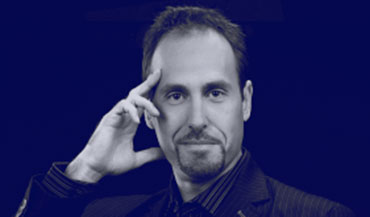The eyes are said to be windows to the soul. And it really is true that they can reveal a lot about what a person is thinking about on a moment to moment basis. The reason they can is that the movement of the eyes, where a person looks, is directly connected to certain types of thought processing. Psychologists call this CLE, or Conjugate Lateral Eye movement. It is nearly impossible to engage in certain cognitive tasks without moving the eyes.
Where a person looks can reveal to you whether he’s visualizing something at that moment, or whether he’s hearing something in his mind, or whether he’s thinking of a feeling or physical sensation. First I’ll guide you through what the direction of a person’s gaze reveals about the pattern of their thinking, then I show you a few ways you can use this information to your advantage.
Ask a person to see a picture of visual image in their mind. You will discover that their eyes will shift. Specifically they will look upward. At one time it was said that the direction they looked, whether upward to the right or upward to the left would reveal whether they were visualizing something they remembered from their past or whether they were seeing an image they were creating in the moment. Later research showed that the direction of their gaze was not a reliable indicator of either of these things. Still, it holds that thinking of a visual image will result in an upward shift in the gaze.
If their eyes shift laterally, neither up nor down, but side to side, they will be thinking of a sound. Again, you won’t be able to tell whether it’s the memory of a sound or something they’re creating in their head for the first time, but they will be thinking sound.
If their eyes shift downward, they will be thinking of a physical sensation.
Now that you know what the direction of a person’s gaze can reveal, let’s look at how you can use this knowledge to your advantage.
The most important thing that eye shift can reveal to you is when a person has moved from being in the moment with you to being inside the world of their own imagination. Depending on context, this information alone can be extremely valuable. Let’s say, for example, that you’re in sales, and you’re describing what the person experience will be like when they buy your product. Suddenly their eyes shift up. You’ve just seen the very moment when they’re visualizing themselves using your product. They would not have begun to visualize if they weren’t interested. So now you know not only that they are interested, but what specifically you just said that created the most interest.
If, in the same situation, they suddenly look to the side, their imaginative experience is auditory. If nothing you were saying was related to sound, then they’re probably holding an imaginary conversation with somebody. Perhaps they’re imagining what they’re going to say to their partner about the product, or what their partner is going to say to them. You won’t know enough to identify exactly what it is their thinking, but you will know enough to start asking more probing questions.
Now let’s imagine that you ask somebody a question, and before responding verbally they shift their eyes. There many books that say that eye shift before a response is a sign of lying. This simply isn’t true. What it really means is that formulating an answer is somewhat difficult cognitive task for them. They have to think a little before they can give their response. What that difficulty means depends upon context. If a response should be easy and readily forthcoming, but still is accompanied by eye shift, it may indeed mean that the person is concocting a story. It may also mean that the person is deliberating over what information to give in order to answer your question and what to hold back.
On the other hand, if your question is one for which you would expect some deliberation, then eye shift would be expected and a positive sign that they are giving your question the thought it deserves. In this case, lack of eye shift would be the most revealing. That would tell you that their answer is rehearsed and that they’ve dealt with your question before.
Possibly the most frustrating thing about body language for the beginner is the realization that no specific meanings are attached to individual behaviors. In order to decode the behavior you have to constantly be thinking and asking yourself how that behavior relates to what is going on in the moment. Eye shift can reveal two important things: that a person has just entered their imagination, and whether they are thinking in visual images, sounds or feelings. If you keep your own head about you, those two pieces of information can allow you to come very close to reading a person’s mind.


No comments yet.